Wednesday, August 31, 2005
Little Patrol Cars•ちびっこパトカー
田舎館に来て、びっくりして、繰り返して見なければならないものの一つは警察官が運転している小さなパトカーです。
These cars are what in Japan is called a keijidosha, or a light car. They are very popular in Japan. I would easily guess that they make up half of the personal use vehicles on the road today. They are inexpensive to cheap, get good gas mileage and, have low insurance and tax costs.
この車は、日本で言う軽自動車で今は大変人気があります。日本の道を走っている個人用の車の半分ぐらいは軽自動車なのではないかと僕は思っています。値段がお手頃で、燃費がよくて、税金や保険料が安いからでしょう。
I can easily understand why other people drive them, but for some reason it seems strange when I see them painted black and white with lights attached to the top. In the USA, patrol cars are generally the largest and most heavy duty vehicles police can find. When you look into a US police car it is full to the gills. There are weapons, computers, radios, walls, restraints, sirens, extra lights, extra batteries. It is almost like a mini tank; there is hardly enough room for the officers and a couple of passengers.
そんなわけで、どうして多くの人が軽自動車に乗っているかはわかりますが、その軽自動車が白黒に塗られて、上にライトが取り付けられて警察の車として使われているのはちょっと変な感じがします。アメリカでは、パトカーって買えるものの中で一番大きくて、一番丈夫な ものに決まっています。その中を見ると、あふれるほど、物が詰まっています。その中に、武器、コンピューター、ラジオ、そして運転席と後ろの席との間には壁があって、犯人が動けないようにするベルトがあって、その他にサイレン、補充のライ トや乾電池などがたくさんあります。まるで、ミニ戦車のようで、警官が座るスペースははもちろん、後部座席にも人が座るスペースはほとんどありません。

Contrast this to the Japanese keijidosha patrol car. It probably isn't more than seven or eight feet long. I think a couple people could pick it up and roll it over if they wanted. Even if you filled it full of stuff, it couldn't hold much. To me all keisha look small and cute, but when you paint it black and white, it seriously looks like a toy.
これを日本の軽のパトカーと比較したら、びっくりです。長さは2メートルとちょっとしかなく、やろうとすれば、力強い2人がひっくり返せるでしょう。そして、人が乗れなくなるまで物を詰めても、あまり入らないような気がします。僕にとって、軽自動車は全部小ちゃくて可愛いものに見えますが、白黒のパトカーだと本当、おもちゃに見えます。
One good explanation for this probably can simply be found in crime rates. Police in Japan deal with far fewer violent criminals and (because Japan is so small) assistance is usually much closer. I would also however maintain that this difference probably stems from the image that police project in both countries. American policemen aim for an independent tough image for themselves, something like John Wayne. Contrast that to Japanese policemen who, as far as I have seen, aim for a helpful and approachable image.
この説明の一つとして、やっぱり、犯罪率の違いがあげられるでしょう。アメリカに比べると日本の警察は、乱暴な行為をするような犯罪者にそんなに遭遇しないような気がします。そして小さい国ですから、援護してくれる警官が比較的近くにいます。しかしなにより、このパトカーに違いは、両国の警察が表そうとしているイメージの相違に基づいているのではと僕は思います。アメリカの警察はジョン•ウエーンみたいに独立性のあり、強いイメージを打ち出そうとしています。それに対して、僕が見た限り、日本の警察はヘルプフルで、近づきやすいイメージを見せようとしています。
It is only my own personal observation, but if I am right and Japanese police are aiming for approachablility, the cute little patrol car is certainly a step in the right direction.
これはすべて僕の勝手な解釈ですが、僕の解釈がただしくて、日本の警察がヘルプフルなイメージを打ち出そうとしているならば、この可愛いちびっこパトカーの選択は正解だと思います。
Monday, August 29, 2005
Tsugaru Dialect・津軽弁
青森に来る前に、東京でJETプログラムの全体のオリエンテーションがありました。そこで会った人 に「青森県に行きます」と僕が言ったら、彼が「もったいないね。せっかく日本語が上手なのにね」と言いました。僕が変な表情をしたから、その次に彼が 「だって、青森では日本語が通用しないぞ。みんなが話していることは君には分からないだろうな」と説明しました。
That was a little bit of an exaggeration, but he wasn't totally wrong. Since coming here I have heard many conversations which I didn't understand. The only explanation that works is people are speaking Tsugaru-ben, of the dialect of this local district.
彼の台詞はちょっと大げさかもしれませんが、完全に間違っているわけではありません。ここに来てから、通じない会話はたくさん聞いています。そして、その説明として、やっぱり、皆さんが津軽弁を喋っているからだと思います。
I personally learn languages by reading. I can hear something 50 times and still not remember it, but if I see it written once or twice, it will stay in my brain. That's why I think learning dialects is so difficult for me. I have lived in Akita for five years but because no one ever writes anything in Akita-ben, I can hardly understand it when my wife talks to her parents.
個人的に、僕は言語を読むことによって覚える人間です。ある言葉を50回 も聞いても、覚えることができませんけれども、同じことを1回か2回を読むと、頭に残ります。それが僕にとって方言が覚えにくい理由だと思います。秋田県 に5年間住んだのに、秋田弁で文書を書く人がいないから、家内が両親とおしゃべりしている時ほとんどは僕に通じません。
Generally speaking, the same is true here in Aomori. Everybody speaks it, but no one ever writes anything down in Tsugaru-ben. Or so I thought. This weekend on the way to an onsen in Kuroishi, I saw many signs by the side of the road. I asked my fluent-in-Akita-ben wife to read them but many she didn't understand.
ここの青森でも同じことです。皆が津軽弁で話しますが、だれも書くことがあり ません。どうやったら学べるでしょうと悩んでいました。しかし、この前の週末、黒石市の温泉に行く途中、津軽弁の看板をたくさん見ました。秋田弁が流暢に使え る家内に意味を聞きましたが、分からなかったものが多かったです。
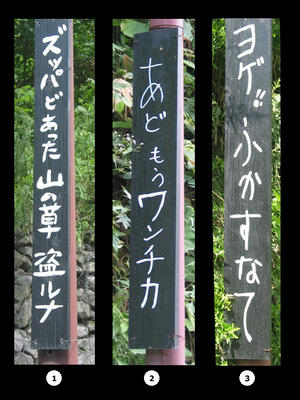
So we took some photos and will try to interpret them below. The italics is what is written on the sign in Romaji; afterwords is an explanation. Thank you to the staff in my office for their language lesson!
その看板を写真に撮って、以下に説明してみます。斜体がその看板の言葉のローマ字です。その後は説明です。英語は必然的に長くなります。役場内の津軽弁を通訳者してくれた皆さん、ありがとうございました。
① Zuppa do atta Yama no Kusa Toruna
'Zuppa' is local dialect for takusan (meaning a lot); the 'do' is a quotative 'to' with a local twist; atta is the past tense of aru (there is); Yama no Kusa is standard Japanese for mountain vegetation; Toruna too is standard command form meaning 'don't take'.
In total it means, "There were a lot of mountain vegetables, don't steal them."
「ずっぱ」は「たくさん」という意味;「ど」は引用の「と」のなまった形だそうです。
② Ado mou Wanchika
Ado is Ato (after) with the local t sound changing to a d; mou is standard Japanese meaning still; wanchika is Tsugaru-ben for sukoshi (a little).
In total it means, "After Still a Little" or "Just a little further" to the onsen.
「あど」と「あと」という意味;「ワンチカ」は津軽弁での「少し」だそうです。
③ Yoge!! Fukasu na te
Yoge is Tsugaru-ben meaning 'hitsuyou ijou' (more than necessary); Fukasu is local dialect for 'to accelerate'; na, like toruna in ① is a negative command; the final te is an abbreviated quotative 'to itte' roughly meaning 'I said'.
In total it means, "Don't drive faster than necessary!
「ヨゲ」は「必要以上」という意味;「ふかす」は「加速する」という意味です。

④ Sutara Sutara Do
Sutara sutara do is Tsugaru-ben equivalent to 'sassa to' (meaning 'quickly' or 'lightly'); the do is a quotative to.
It sign was probably directing people to not stop and enjoy the scenery too long, because it might cause a traffic accident on the very curvy road.
「スタラスタラど」は標準語で「さっさと」という意味だそうです。
⑤ Dondaba sono Fubarigata
Dondaba doesn't have a good translation in standard Japanese but roughly translates as Oh, my god!; sono is standard Japanese for 'that'; Fubari is a root of 'fubaru', which is a dialect form of 'hipparu', which usually means to pull, but in this case means to drive: gata is a local pronunciation of 'kata', meaning 'way of'.
In total it means, "Oh my god, your driving!"
「どんだば」は標準語にはいい言葉がないですが「オオ、マイゴッド」という意味だそうです。「ふばる」が「引っ張る」から来るそうで、この場合には「運転する」という意味です。
⑥ Sappado shita be
Sappado in standard Japanese would be 'sappari' (meaning 'clean' or 'refreshed'); shita is past tense of 'to do'; 'be' is the ubiquitous northern Tohoku dialect equivalent of standard Japanese's 'deshou' (meaning 'wasn't it').
In total it means, "You were able to be refreshed, weren't you?" (on a sign soon after leaving the hot spring bath).
「さっぱど」は標準語でいうと「さっぱり」という意味です。「べ」は東北どこでも聞く「でしょう」と意味を持つ言葉です。
This was very good practice for me. Hopefully you too learned something!!
僕にとって、これは大変いい勉強になりました。皆さんも勉強になりましたか?
Saturday, August 27, 2005
Fire towers • 消防のタワー
この前、田舎館を通ってドライブしている時、消防団のタワーが村中あちこちにあることに気がつきました。以前日本ではこういうタワーを見たことがありますが、田舎館にあるものの数、そしてそれがきれいに保存されていることに感動しました。そのタワーや鐘などには錆がなく、きれいにペンキが塗られています。

In most small towns and villages in Japan, there is both a volunteer firefighting squad and professional firefighters hired by the municipality. Most volunteer squads have a shed which houses their equipment and most often a vehicle or pump. In Inakadate there are six such squads with 19 vehicles spread throughout the 21 neighborhoods.
日本の小さな町や村のほとんどにはボランティアの消防団も市町村レベルで採用されている公務員の消防士もいます。そして各消防団には、自動車やポンプなどの装備を保管できる小屋があります。田舎館には6つの消防団があり、村中の 21個の集落に19 件の小屋が設けられています。
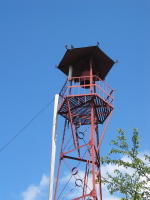
In most cases it is the role of the volunteer squad to keep local materials available and well maintained and to offer assistance to the professionals when needed during a fire. I am sure there is a lot of teamwork between both groups.
普通の場合にはボランティアの消防団は、火災時にその地域で使う必需品を整えておくことと必要な場合に消防士をサポートする役割を果たしていると思います。間違いなくボランティアとプロの間に、協力的な関係があると思います。
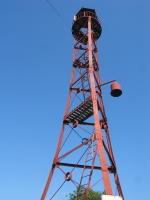
A fire tower is one of things you hope you will never need to use, but one you are glad you have when you need it. If the beauty of the fire towers is a reflection of Inakadate's disaster prevention readiness, I can feel comfortable knowing that when the time comes, people here are ready.
消防のタワーを使う必要がなければそれにこしたことはありません。しかし、必要な時にそれがあれば便利だと思います。田舎館が災害に対してどのくらい準備をしているかはまだ僕には分かりませんが、この消防タワーが”どんな災害がきても大丈夫”という安心感をもたらしてくれているように思います。
Friday, August 26, 2005
The Castle Village Hall・お城の役場
田舎館村役場を紹介しようと思います。間違いなく、この役場は田舎館村の中で、一番目立つ建物です。下の写真を見ていただければ、どうしてかおわかりいただけると思います。それはつまり、村の役場は昔の日本の城に似ているからです。

The building was build about ten years ago and occupies a corner on the 'main street' through Inakadate。Next to it across the parking lot are the community center and village gymnasium. The village hall is officially two buildings, the village hall and the Culture Center, but the two are adjoining and little distinction is made between the two.
この建物は約10年前に建てられ、田舎館の'メイン・ストリート'の一角に位置しています。駐車場を渡ったら、隣には公民館や村民体育館があります。正式的にはこの施設は役場と村民文化会館の2つの建物に分かれています。隣同士であり、あまりはっきり分かれていないように思います。
In addition to more customer related services like the Residents Division, the first floor of the village hall has several large display cases featuring local products. My desk is on the second floor, along with the mayor's office and the Construction Division. The third floor has the Village Council and the Board of Education. The fourth floor has a coffee shop. The fifth floor is just a stairway and the sixth floor is the castle keep (or lookout tower).
住民課など、村民にサービスを与える係りのほかに、1階には村の特産品を展示 している大きいショーケースやリラックスできるロビーがあります。2階には僕の所属している総務課のほかに、村長のオフィスや建設課があります。3階には、村の議会の会議室と教 育委員会があります。4階は喫茶店とギフト・ショップです。5階は何もなく階段だけで、6階は天守閣(展望台)になっています。
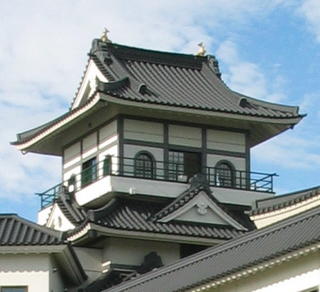
From this top floor is a wonderful view. These days, many people climb to the top to view the Tambo Art, right across the street, but visitors can see most of the southern Tsugaru plain and Mts Iwaki and Hakkoda further in the distance. In keeping with the castle theme, the property also has a gated entryway and a small moat in front of the building filled with colorful carp.
この一番上から非常にいい景色が見えます。この頃、多くの人々は目の前にある 田んぼアートを見るためにそこまで上っています。しかし、その天守閣から南津軽平地のほとんどや岩木山と八甲田山も見えます。お城のテーマに基づいて、役 場の前には大きな門とカラフルな鯉がたくさんは泳いでいるお堀があります。
Finally, the Inakadate village hall is a great place to work. It is spacious and comfortable and filled with many friendly people. I like it here very much.
田舎館村の役場は大変いい職場です。広くて、働きやすいところです。そして僕にとってもっとも大事なのは、この中に親切でフレンドリーな人々がたくさんいることです。
Thursday, August 25, 2005
Better than TV・テレビより面白い
夕べ8時ごろ、居間で座ってテレビを見ていました。僕は何も聞こえませんでしたが、突然家内は「何か聞こえた?ちょっとテレビの音を低くして下さい」と言いました。当然のことですが、窓がフルに開いていたんですが、 10秒ぐらいしたら、アパートから遠く離れたところから5つの音符ででできた簡単なメロディが聞こえてきました。もう少し聞いたら、その歌が15 秒ごとに繰り返されていることに気がつきました。
I guessed it was someone selling something―similar to the clam salesman I mentioned before who comes around about once a week in the mornings. My wife got a little excited. She thought it was probably either a ramen salesman or a baked potato salesman.
前に書いたように、朝早くから来る蜆売りと同じく、誰かが何かを売っているんでしょうと僕は思いました。それに対して、家内が少し興奮していました。彼女は「ラーメン屋さんか石焼き芋屋さんだ」と言いました
Eventually the sound died out. But then gradually it came back louder and clearer than before. We listened and soon it seemed to stop somewhere nearby. Curiosity was getting the best of my wife. She said, "if it is the baked potato man, I might ask him to come every night." She sent me out to see what it was.
そのうちに歌が聞こえなくなりました。しかし、ちょっとしたら、前より近くて 大きく聞こえるようになりました。しばらくすると、近くのどこかで止まったような感じがしました。好奇心がいっぱいの家内は、「それが焼き 芋屋さんだったら、美味しいでしょう。毎晩来るように頼もうかな」と言い、だれだか見てくるようにと僕に頼みました。
I grabbed my camera, put on my shoes and walked around the block following the sound. There I found the origin of the sound. It was a little tiny van with a speaker on top and a "Ramen" lantern hanging off the back hatch. There were two people working inside and they were preparing at least 6 bowls of ramen. Just as I walked up, the jumped out of the van and ran the noodles into a nearby house.
カメラを持って、靴を履いて、音を聞きながら近所を歩き始めた。2ブロックぐらい行ったところで、『音源』を発見しました。大きなスピーカーが乗っている小さなボックス・カーでした。そして開いているうしろのハッチから「ラーメン」の提灯が地面に付くぐらい大きくぶら下がっていました。その中で 2人が一生懸命6杯ぐらいラーメンを準備していました。ちょうど僕が近づいたら、その2人が車から飛び降りて、その辺の家へラーメンを持ってダッシュしていきました。

I took this photo and walked on. Before I had gone 20 meters the two people had returned to the van, gotten in and driven away. Probably from order to delivery, it had taken them less then five minutes.
僕はこの写真を撮って、アパートへと歩き始めました。20メートルも歩かないうちに、その2人が車に戻って、乗りなおして、ゆっくりしたペースで走っていきました。注文から配達まで5分もかからなかった感じでした。
It was a simple thing, but it was much more interesting to watch than the TV.
ちょっとしたことでしたが、僕が見ていたテレビ番組よりずっと面白かったです。
Wednesday, August 24, 2005
A Surprising Mountain ・ びっくりの山
きのう、びっくりすることがありました。村の要覧などで岩木山について読んではいましたが、見たことはありませんでした。でもきのうの午後その岩木山を四週間目にして初めて見ることができたんです。
Now it is not easy to hide a mountain, especially the tallest mountain in Aomori prefecture, but until yesterday I hadn't seen Mt Iwaki. There were cloudy days and rainy days, but most days the problem was haze. Probably because of the high humidity (and probably some pollution too), there have been many hazy days.
山ほど大きいな物、特に青森県で一番高い山を隠すことはなかなかできないと思うんですが、きのうまで岩木山をはっきりと見ることができませんでした。曇りの日や雨の日もあったんですが、何よりも霞が問題だったようです。湿気(そしておそらく空気汚染も)のせいだと思いますが、霞がかかっている日がこの一ヶ月ぐらい続いていました。
I have seen the bottom foothills and once or twice seen the a top corner or edge, but yesterday, after one of the big rainstorms, the clouds went high enough and I saw the whole mountain for the first time.
下のふもとは数回、そして頂上の一部は1回ぐらいうっすらと見えましたが、きのう、大雨が降った後、雲が高くあがって全体を見ることができました。

It was backlight and still had some clouds near the peak, but still it was a wonderful sight to see. I climbed to the top of the yakuba and took this photo. Very beautiful!
逆光で、頂上あたりには、まだ薄い雲が残っていましたが、それでも見事でした。役場の天守閣まで昇って、この写真を撮りました。素晴らしかったです。
Monday, August 22, 2005
A Humid Summer ・ 蒸し暑い夏
ここに来て、4週間が経ちますが、その間毎日がムシムシしている感じがします。ちょっと涼しい晩は1日か2日あったんですが、「もうちょっと涼しければ、いいのになあ」と思わない日はありません。来てから、暑くて毛布をまだ一回も使っていません。
I grew up in Minnesota. Minnesota, at about 49 degrees north latitude, is the furthest north state outside of Alaska and summers are usually cool. In addition, my parents home is in Duluth, near the shore of Lake Superior. Lake Superior is big and always cold and it really affects the weather in Duluth. Winters are warmer and summers are cooler because Lake Superior is nearby. I say 'warm winter', but still it is sometimes -30, likewise 'a cool summer' is still sometimes +30.
僕は、北緯49度にあるミネソタで育ちました。ミネソタはアラスカ以外にアメリカで最北の州で、夏もそんなに暑くなりません。僕の両親の家はスペ リオル湖の湖畔にあるダルース市にあります。スペリオル湖は大きくて、冷たい湖で、その近辺の天気に大きく影響しています。スペリオル湖のおか げで、ダルースの冬は「より暖かい」、夏が「より涼しい」とよく言われています。しかし、「暖かい冬」と言っても、マイナス30度の日もあり、「涼しい夏」と いっても摂氏30度の日もあります。
So it is the same 30 degrees, but I don't remember Minnesota summers to be this hot. I think this is because of the humidity. Here in Aomori we have oceans to the north, east and west of us. And that must affect the humidity. When my wife and I first decided to come back to Japan, one of the first things she was excited, but one of her first worries was, 'we're going back to that humid country?'
同じ30度ですが、ミネソタで夏がこんなに暑いと思ったことはないような気がします、それはきっと、ここの湿度が高いからでしょう。ここの青森では、北 にも、東にも、西にも海があるからでしょう。三方が海で囲まれていることで湿気が上がるのでしょう。家内と2人で、日本に来ることを決めて、彼女が一番に心配したことは「あのムシムシしている日本に帰るんですか」だった。

Last week I attended an orientation for all the new JETs in Aomori-city. There we learned about sights of Aomori prefecture, about how to do our jobs, and about the resources available to us. There was also one workshop called 'Everyday Life in Aomori' and there one of the presenters talked about how to live in a humid; country-how to be more comfortable, how to protect your clothes etc.
先週、青森市に新しく来た英語の先生や国際交流員のオリエンテーションに参加しました。そこで青森県の名所について、ここでの仕事について、そして私たち が使える教材や施設について色々勉強してきました。もう一つのワークショップは「青森での日常生活」をテーマにしたものでした。そこでの一番面白い発表は 「湿度の高い青森での暮らし方」で、湿気から服を守る商品などを紹介しました。
These days there seem to be lots of rain and thunderstorms. I am surprised by that. I don't remember too many such storms in Japan. Here in August I would expect typhoons. Whatever the case, whether the rain comes from a storm or a typhoon, the result is a further jump in the humidity level.
この頃、嵐や雨が多い感じがします。それでちょっとびっくりしています。日本で7回夏を過ごしましたが、こんなに嵐 のある夏は初めてです。日本の8月には台風もたくさん来るし。。。しかし、結局、嵐であっても、台風であっても、ただの雨で あっても、結果は同じ、湿度が上がることです。
I am looking forward to the cool and dry days of autumn.
秋の涼しくて、カラッとしている日々を楽しみにしています。
Tuesday, August 16, 2005
Fires of Obon ・ お盆の送り火
実を言うと、お盆の間、田舎館にはほとんどいませんでした。金曜日の夕方仕事が終わってから、家内と一緒に、彼女の秋田市の実家に帰りました。そこで、日本人がいう「普通のお盆」を過ごしたと思います。

On Saturday, along with my wife's mother and father we went to the temple and to the graveyard. At the graveyard we cleaned everything; set up the candles, incense, horses made from a cucumber and an eggplant and flowers; prayed and then left. On Sunday some friends and relatives came over for a while. Nothing too special I think.
土曜日に、家内のお母さんとお父さんと一緒にお寺やお墓に行きました。お墓では、全てを掃除してから、ろうそく、線香、きゅうりと茄子でできた馬そして花を設置して、お祈りをして、帰りました。日曜日に何人かの親戚や友だちが遊びに来ました。普通のお盆でした。
Yesterday I drove home from Akita. As I was driving into Inakadate just after dark I saw something I have never seen before. Perhaps it is just a matter of good timing, but as I was coming into the village from Hirosaki, I saw several small fires in peoples front yards and gardens.
そして、きのう秋田から帰ってきました。ちょうど暗くなった頃、田舎館に入ってきたら、見たことがないことを見ました。たまたまタイミングがよかったかも知れませんが、小道で弘前から入ってきたら、民家の家の前や庭に焚き火を見ました。
I read in textbooks in Anthropology and Sociology that Japanese people light fires during Obon to welcome or send off the spirits of ancestors. I have also been to several Obon dances where there is always a large fire, so therefore I recognized that this is probably what these people are doing. But in reality, yesterday in Inakadate was the first time that I have ever seen a private individual family light a fire like this.
「お 盆の 頃、日本人が先祖を迎えるまたは見送るために、火を点ける」ということは社会学や人類学の教科書で読んだことがあります。または、盆踊りに行って大きな火 が燃えていること も見たことがあります。だから、きのうの人たちが何をしているか分かりましたが、そのように個人の家族が自分の所で焚き火をすることは、きのうの 田舎館で初めてでした。

For someone who is interested in traditional Japanese culture, this was a good thing to see.
日本の伝統的な文化に興味がある僕にとって、大変いいことを見てしまった感じです。
Saturday, August 13, 2005
Matsuri Season ・ 祭りのシーズン
一番最初の日記に田舎館のねぷた祭りについて少し書きましたが、東北の祭りシーズンは非常に大事な時期ですので、もう少し書きたいと思います。8月、特に8月の上旬に、東北地区は他に見ることができない音や光や動きで活気を増します。本当に見る価値があります。
 This year I have been to five festivals. On August 2, 3, and 4, I participated in the Inkadate Neputa festival. On the 5th, I went to Aomori-city and participated inthe Nebuta festival there. On the 6th, I was in Goshogawara and although it was the day, I visited the Nebutakan and saw the floats. That evening, I went with my wife and friend to see the Neputa festival in Hirosaki. Finally, on the 7th, I went to Kosaka-machi in Akita and participated in the Tanabata festival. It was a very busy week.
This year I have been to five festivals. On August 2, 3, and 4, I participated in the Inkadate Neputa festival. On the 5th, I went to Aomori-city and participated inthe Nebuta festival there. On the 6th, I was in Goshogawara and although it was the day, I visited the Nebutakan and saw the floats. That evening, I went with my wife and friend to see the Neputa festival in Hirosaki. Finally, on the 7th, I went to Kosaka-machi in Akita and participated in the Tanabata festival. It was a very busy week.今年、僕は5つの祭りを観覧し、また参加することができました。8月2、3、4日に田舎館のねぷたま つりに参加しました。5日に青森市に行って、ねぶた祭りに参加しました。6日に五所川原にいたので、日中でありながら、外に出している立佞武多の山車や佞 武多館 を見ることができました。その晩、家内と友だちと弘前のねぷたを見に行きました。そして最後に、7日に秋田県の小坂町の七夕祭りに参加しました。大変忙し い一週間でした。
Festivals like the Nebuta festival in Aomori and the Kanto festival in Akita have become national events which bring millions of tourists to the area. I don't think that that is a bad thing, but certainly that isn't the reason for having a festival. Rather I think that festivals are important because they bring people together. They are a time where people can meet and get to know each other.
青森のねぶたや秋田の竿灯まつりは何百万人の観光客を呼ぶ全国的なイベントになっています。それは悪いことではないですが、 それが祭りを開く理由にはならないと思います。かえって、祭りのよさとは、人を一緒にすることです。人が互いに会って、知り合う場として祭りがいいです。
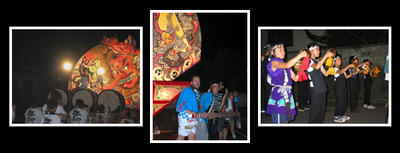 That is the reason that I most enjoyed the festivals in Inakadate and Kosaka. There I was able to fully participate in the festival, but more importantly I was able to meet and talk to many people. Most of the time there is plenty of time at these festivals to sit, eat, drink and communicate with neighbors and friends.
That is the reason that I most enjoyed the festivals in Inakadate and Kosaka. There I was able to fully participate in the festival, but more importantly I was able to meet and talk to many people. Most of the time there is plenty of time at these festivals to sit, eat, drink and communicate with neighbors and friends.それが田舎館と小坂町の祭りを一番楽しめた理由です。両方にも参加できましたが、それ以上に人に会って話ができたことはよかったです。こういう祭りでは、近所の人や友だちとゆっくり座って、食べて、飲んで、コミュニケーションをとる時間がたっぷりあるからです。
Long ago, almost all of these festivals originated in prayers for a bountiful harvest. Now however, with few people directly dependent on agriculture, the festivals continue. I think that is probably because festivals play in important part in community building. In both the festivals I really enjoyed, in Inakadate and in Kosaka, I was able to help with the preparations for the festival. These preparations sometimes take a month or more. As community members (who unfortunately seem to be mainly men) come together to help get ready for the festival, they communicate and build a community.
祭りというのは、豊作を願う祈り に基づいているそうです。しかし、農業に頼って生活している人がかなり減った今でも、祭りは続いています。それは、祭りがコミュニティづくりに大事な役 割を果たしているからだと思います。今年、本当に楽しめた田舎館と小坂の祭りでは祭りの準備にも少し手伝うことができました。この準備は1〜2ヶ月間がか かりますが、この間そのコミュニティのメンバー(残念ながら、手伝う人のほとんどが男性のようですが)はひんぱんに会って、コミュニケーションを取って、 コミュ ニティを作っているようです。
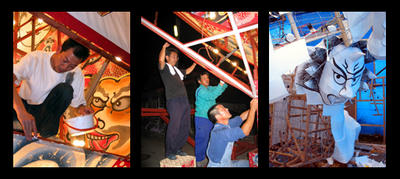
I was very happy to be able to participate in the Inakadate festival and its preparations. I felt like one of the community.
田舎館のねぷた(とその前の準備)に参加することができて、大変嬉しく思っています。コミュニティの一員になれたという感じでよかったです。
Friday, August 12, 2005
Lots of Flowers ・ 花が豊富
僕は普段に花を気にする人ではありません。しかし、田舎館に来てから、この村の花の数や美しさに大きく感動しています。村の道を歩いている時、色が明るくて、美しい花を数えきらないぐらい多く見ています。本当に見事です。
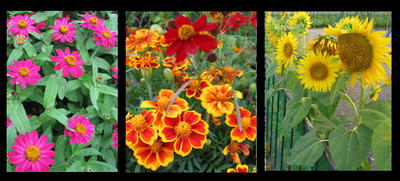
Usually in Japan, each house is surrounded by a brick wall and there usually isn't too much to be seen but the road in front of you. But Inakadate seems to be different. Here you find the ubiquitous Japanese concrete walls, but it seems to me that the entryways are slightly wider (and perhaps more welcoming) than other places I have visited.
日本では、多く の家々がコンクリートの塀に囲まれ、目の前の道路以外に見るものがあまり多くないです。しかし、田舎館はちょっと違うようです。この村にも日本のどこでも ある塀もあるんですが、入口となっている塀の間のすき間がなんとなく広い(または歓迎している)感じがします。
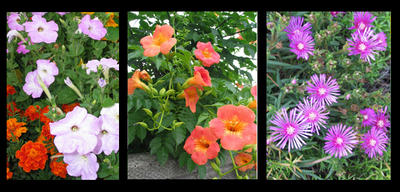
Through these driveways and entryways one can see many interesting things. There are orchards and greenhouses, homes and garages, tractors and tillers, vegetable gardens and trees and of course now in the summer there are flowers. I like to work in the garden, but generally speaking, it I can't eat it, I don't bother to grow it. I don't know much about flowers. Beyond the size (it's big; it's small) and the color (it's red, it's blue) I can't say too much.
この玄関先や車の入口から色々な 面白いことが見えます。果樹園やハウス、家や車庫、トラクターや耕耘機、畑や木々、そして夏の今には花も山ほど見ることができます。僕は、畑仕事が好き (趣味程度)ですが、基本的に口に入れるものにならなければ、あまり育てる気がしないんです。というわけで、花のことは何も分かりません。大きさ(小さい です)や色(赤いです)以外に、私にはなんとも言えません。

But I can say that here in Inakadate there are many flowers- many big flowers, many small flowers, many red flowers, many white flowers. Thank you to the people who grow them.
しかし、田舎館村には、大きい花も、小さい花も、赤い花も、白い色い花も、とにかくたくさん花があること、確信を持って言うことができます。育てている人に感謝します。
Thursday, August 11, 2005
Early Risers ・ 早起きの村
普通に言うと、私は朝の人で はありません。ただ来てから、時差ぼけのせいで毎朝早起きしていたんです。着いてからもう2週間以上が経って、時差ぼけが もう取れた感じです。今は眠れるようになりました。しかし、それと同時に、この辺の人がどれぐらい早起きしているか分かってきました。以前に眠れなかった の で、朝早くから動いても、気にしなかったですが、今は朝が随分にぎやかだと思うようになりました。
First of all, there is the chime broadcast by the neighborhood announcement system every morning at 5:00am. To the best I can tell, it is just announcing the time. Then recently there have been announcements of the village festival; who, when, where and how. Those started about 6:00am. This morning, there was a truck (I assume it was a truck- I didn't get up to look) driving through the neighborhood selling freshwater clams from a nearby lake. I think it was a recording, but at 6:15 this morning it kept loudly repeating 'Freshly caught clams from Lake Jusan; How about some freshly caught clams?...' over and over again.
まず、毎朝5時に、村内放送 システムからチャイムが流れます。私が知っている限りそれはただ時間を発表しているものです。そして、最近村の祭り関係の発表-誰、どこ、いつなどの放送 -が多くありました。それはだいたい6時からです。そして今朝、近隣の湖で採れた蜆を売るトラック(起きて見なかったがトラックだったと思います)がゆっ くりと村内を通りました。録音だったでしょうが、6時15分からそのトラックから「十三湖から採りたての蜆はいかがですか?」と次々と繰り返しました。
But it is just not announcements. A week or so at 6:00am I laid in bed and listened to someone outside my window trimming shrubs. That tells me that someone is listening to these announcements; that someone is making use of the early morning light. I am glad someone is. Without Daylight Savings time, it is getting light here before 5:00am and if no one was using it, it would be a huge waste.
しかし、発表や放送だけではないです。先週、 朝6時にベッドに寝ていて、窓の外あたりで生垣を切っている音が聞こえてきました。その音で、だれかがこの発表を聞いて、朝の太陽の光を利用していることは 分かりました。それは大変いいことです。アメリカみたいに夏時間がないため、もう5時前から明るいですので、その明るさを使っている人がいないと非常に もったいないことだと思います。
And I know this won't last. I'll get used to the sound and once it cools off and I can close my apartment windows at night, I probably won't hear too much of this and things will be good. Then I'll have to be careful not to oversleep for work though!
そして、これが長く続くことはないと分かります。慣れるし、もう少し涼しくなって窓を閉めて寝ることができたら、外のにぎやかな朝が聞こえなくなるでしょう。それでゆっくり眠れるでしょう。しかし、そうなったら、寝坊して、仕事に遅れないように気を付けなくちゃ!
Wednesday, August 10, 2005
Rice Field Art ・ 田んぼアート
最近の、田舎館村の名所とは、やっぱ り「田んぼアート」です。「田んぼ」というのは「米の畑」という意味ですから、「田んぼアート」というのは米の畑での 美術です。春には、田舎館村の皆さんが役場の近くの田んぼに3種類の米を植えました。伸びてきた今では、役場の展望台から巨大な絵が見ます。今年のアート は2つの浮世絵です。

This year's 'art' features two Ukiyoe images; past years have featured the Mona Lisa, a rice plant, Yayoi era people and others. Everyone says this year's image is the best and I have to agree. Others throughout the world too are hearing about our Tambo art as it has appeared in the Mainichi Daily News and on the internet. On September 25th, the two images will disappear as the town holds the Rice Cutting Experience Event. All those interested in participating are welcome. Contact me for more info.
前年にはモナリサや稲などの絵に挑戦しました。皆さんが「今年が一番いいです」と言っています。僕も賛成し ます。毎日新聞の英字新聞やインターネットにも載せられ、世界中の人々が私達の「田んぼアート」を知るようになっています。今年の絵が9月25日になくな ります。その日に、稲刈り体験ツアーを開催するからです。参加したい人はぜひ来て下さい。質問があったら、私に連絡してください。お待ちしています。
Tuesday, August 09, 2005
First Impression ・ 第一印象
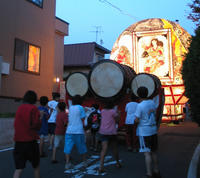
I have been here a little over two weeks and it has been very busy. There have been many things going on all over town. Last week was the Neputa festival. The 17 neighborhoods within Inakadate each made a float which was pulled around the town. The biggest day was on the 4th when everyone gathered together and paraded from the junior high school to the village hall. It was a lot of fun.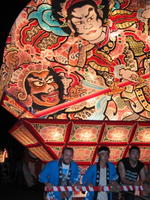
こ の田舎館村についてから、約2週間が経っています。来てから大変忙しくしています。村中たくさんイベントなどがありました。先週が田舎館村のねぷた祭りで した。村内の17の集落がそれぞれねぶたを作って、村中を引っ張って歩いていきました。祭りのピークは皆が中学校から村役場まで行列を作って、パレード形 式で村を通った8月4日の晩でした。大変にぎやかで楽しかったです。
Free Web Counter